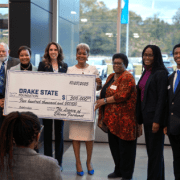Higher Education Powers Huntsville’s Economy, but May Face Headwinds
The city’s higher education leaders are bullish on the future. At the 2025 State of Higher Education event hosted by the Huntsville/Madison County Chamber, presidents from the University of Alabama in Huntsville (UAH), Alabama A&M University, Calhoun Community College, and Drake State Community & Technical College outlined how their institutions are fueling Huntsville’s economic engine while also acknowledging new challenges on the horizon.
At the forum, each institution reported rising enrollment and reinforced its commitment to aligning education with Huntsville’s evolving workforce. Calhoun Community College announced record enrollment of 10,141 students, underscoring its role as the largest feeder of skilled workers in North Alabama. Its new 57,000-square-foot Advanced Manufacturing Center has already become a hub for industry training, equipping students with skills directly applicable to aerospace, automotive, and healthcare industries.
Drake State Community & Technical College also marked impressive progress, reporting a 26 percent increase in enrollment over the past year. Dr. Patricia Sims, president of Drake State, said this growth reflects the school’s focus on short-term credentials and career re-entry programs, which are opening doors for residents seeking high-wage, high-demand positions. “We see our mission as empowering families through education,” Sims said. “When a student gets a certification and a job, the entire household’s trajectory changes.”
Meanwhile, the University of Alabama in Huntsville emphasized its retention and local impact, noting that 80 percent of UAH graduates remain in the Huntsville area after graduation and 85 percent stay within Alabama. UAH President Dr. Charles L. Karr highlighted that the university’s partnerships with defense and aerospace employers are not only fueling job growth but also driving innovation that keeps Huntsville competitive on a global scale. UAH’s partnerships with defense and aerospace employers like Boeing, Dynetics, and NASA Marshall Space Flight Center create direct employment pipelines that strengthen the city’s economic ecosystem.
Alabama A&M University, celebrating more than 150 years of service, shared updates on its 10-year master plan that includes expanding STEM facilities, modernizing student housing, and increasing capacity for physical and analytical sciences research. Dr. Daniel K. Wims, president of Alabama A&M University, stressed that A&M’s mission remains rooted in serving the local and regional community. “Our purpose is not just to educate,” Wims said, “but to uplift the community that has supported us for generations.”
Economic Engines with Local Impact
Collectively, Huntsville’s higher education institutions represent a massive portion of the region’s economy. Calhoun’s annual economic contribution alone is estimated at $802.8 million, accounting for 1.8 percent of North Alabama’s gross regional product. Over the last five years, UAH researchers have secured more than $639 million through contracts and grants and generated nearly $700,000 in licensing and royalty revenue from a portfolio of 187 active patents. Meanwhile, Alabama A&M contributes approximately $279.2 million to the local economy each year. Drake State’s growing footprint in workforce training, particularly in manufacturing, construction, and healthcare, adds $21 million more. Oakwood University, which was not represented in the panel, nevertheless contribute an annual $92.6 million in direct economic value.
Dr. Jimmy Hodges of Calhoun Community College highlighted how advisory boards composed of local business leaders guide the college’s curriculum to meet real-time needs. “We meet regularly with employers,” Hodges said. “If they tell us they need 200 more machinists or nurses next year, we adjust. That’s what community colleges are built to do.”
Serving Beyond the Classroom
The presidents also emphasized how their campuses support community well-being beyond academics. Calhoun offers continuing education and GED programs for adult learners, along with childcare support for working parents. Drake State runs small business development workshops and partners with the city to offer free technology training for veterans and displaced workers.
At Alabama A&M, faculty and students participate in dozens of outreach programs each year, from tutoring local high school students in math and science to hosting agricultural extension workshops for North Alabama farmers. UAH’s engineering students regularly collaborate on local infrastructure projects, providing analysis and design support for public safety and environmental sustainability initiatives.
These community programs have measurable economic and social effects. According to a recent ACCS report, for every dollar invested in higher education, Alabama sees an average return of $6.50 in long-term economic value through job creation, higher wages, and increased local spending.
Challenges and Federal Uncertainty
Despite the optimism, leaders acknowledged the growing strain of financial and demographic pressures. Hodges described a “constant balancing act” between affordability and innovation, especially as state and federal funding stagnates. Wims pointed to aging infrastructure and competitive faculty recruitment as critical concerns, noting that A&M’s ability to attract top researchers depends on sustained investment.
The ongoing federal government shutdown has added another layer of uncertainty. While federal student aid programs like Pell Grants remain operational, furloughs within the Department of Education and related agencies have slowed approvals for grants, research funding, and compliance reviews.
Looking Ahead
Even with these challenges, Huntsville’s colleges remain deeply interwoven with the region’s growth strategy. Each president reaffirmed a shared vision: education not as a separate sector, but as the foundation of the city’s economic resilience and community well-being. “Our universities and colleges are the foundation of Huntsville’s growth,” Hodges said, “We’re not just producing graduates, we’re producing the future workforce, the innovators, and the civic leaders who will keep this region thriving.”
















